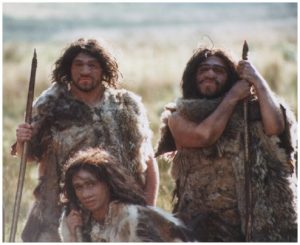Religion – When, Why and How did it begin?
“The alter cloth of one aeon is the doormat of the next.” Mark Twain
‘I’ll find my way home’ by Jon and Vangelis – on their spiritual journey

So were the Neanderthals the first hominids to be aware of religion? Evidence does suggest so. What do we know about them? We know they had a culture, planning abilities, a ritualistic type of life. They had similar abilities that we have today, but probably in a more basic form. We know they were unselfish in their concerns for their young, their sick and their elders and were altruistic in nature. There is evidence that many lived longer than their individual life expectancy, perhaps cut short due to illness or injury, suggesting that the social unit looked after the sick and the infirmed. However their altruism did appear to be localised within small groups rather than universal altruism within their species (Is this why they became extinct?).
We know they sometimes buried their dead. And we know they were smart. There average cranial capacity was comparable to our own. In fact modern paleoanthropology hypothesizes the social status of the Neanderthals as “intelligent species” and while living in social groups in caves they developed rituals and spirituality.
Other researchers have found this controversial and have challenged these interpretations, particularly regarding Neanderthal burials. They suggest that graves may have been dug just to remove corpses from sight or for hygienic reasons. And this happened only in more recent times and as a result of a behavioral mechanism to protect themselves from the dangers of rotten meat. Neanderthals instinctively reacted to their dead as carrion and buried the dead for that reason.
Or perhaps burials took place just to reduce the risk of prey animals or scavengers arriving at the Neanderthal refuge and the dangerous consequences that may have. We see this often today on ‘wildlife’ programs where animals will bury or cover their ‘kill’ or ‘find’ so as not to attract unwarranted attention (and in their case to maintain possession for future consumption).
Also, perhaps the Neanderthals had practical rather than religious reasons for positioning dead bodies. For instance, a body manipulated into a fetal position would need a smaller hole for burial, making the job of digging a grave easier. And perhaps they didn’t adorn the corpses or accompany them with animal bones as these and the flower pollen near the corpses could have been deposited by natural forces.
Also, many scientists once thought that fossilized bones of cave bears (a now-extinct species of large bear) found in Neanderthal caves indicated that these people had a so-called ‘cave bear cult’, in which they worshiped the bears as powerful spirits, further testament to their belief in an afterlife. However, after careful study researchers concluded that the cave bears probably died while hibernating and that Neanderthals did not collect their bones or worship them.
So considering current evidence, the case for religion among Neanderthals remains controversial.
And Neanderthals never developed language, which was essential for communicating their ideas and thoughts to each other and vital for propagating anything we might regard as religion to their descendants. On the other hand, Homo Sapiens did develop language and as a by-product of this language perhaps the idea of God and religion developed and evolved in our minds. The idea of God and the formation of organised religion may have created a sense of universal altruism among our species which was an advantageous trait in the survival and propagation of our species. Perhaps the earliest evidence of religion is from the Neanderthals, but the jury is still out! (Homo Sapiens coexisted along side Neanderthals. Is there any evidence to indicate that we buried our dead in the Upper Paleolithic era?)
Recent Comments